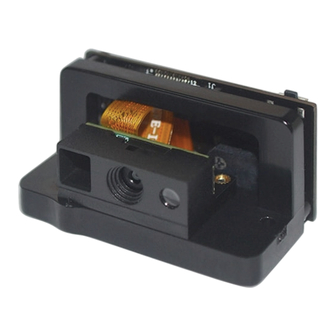
Table of Contents
Advertisement
Quick Links
Advertisement
Table of Contents

Summary of Contents for RTscan RT214C
- Page 1 RT214C Integration Guide RT214C...
-
Page 3: Table Of Contents
Contents Introduction ......................................2 Illumination ......................................3 Aimer ........................................3 Introduction ......................................4 General Requirements ................................... 4 ESD .......................................4 Dust and Dirt ....................................4 Ambient Environment ...................................4 Thermal Considerations ................................5 External Optical Elements ................................5 Mounting .......................................6 Housing Design ..................................... 7 Optics ........................................7 Window Placement .................................. -
Page 4: Introduction
Introduction The RT214C is an area image engine for barcode reading. It includes an illumination LED and an aiming LED. The RT214C complies with IEC 62471:2006 for LED safety. LED Compliance Statement The RT214C contains: a CMOS image sensor and its lens an LED based illumination system •... -
Page 5: Illumination
Aimer The RT214C contains a red LED aimer to help the user to easily position the target barcode within the engine’s field of view to increase scan efficiency. The aiming pattern can be turned On or Off. It is advisable to turn it on when scanning barcodes in regular circumstances. -
Page 6: Introduction
Dust and Dirt The RT214C must be sufficiently enclosed to prevent dust particles from gathering on the lens and circuit board. Dust and other external contaminants will eventually degrade the engine’s performance. -
Page 7: Thermal Considerations
Thermal Considerations Electronic components in the RT214C will generate heat during the course of their operation. Operating the RT214C in continuous mode for an extended period may cause temperatures to rise on CPU, CIS, LEDs, DC/DC, etc. Overheating can degrade image quality and affect scanning performance. Given that, the following precautions should be taken into consideration when integrating the RT214C. -
Page 8: Mounting
Mounting The illustrations below show the mechanical mounting dimensions (unit: mm) for the RT214CC. Note: Tolerance of dimension is ±0.15mm. -
Page 9: Housing Design
It is recommended to use baffles or matte-finished dark internal housing colors. Optics The RT214C uses a sophisticated optical system. An improperly designed internal housing or improper selection of window material can degrade the engine’s performance. Window Placement The window should be positioned properly to let the illumination and aiming beams pass through as much as possible and no reflections back into the engine (reflections can degrade the reading performance of the engine). -
Page 10: Window Material And Color
Figure 2-2 Table 2-2 Distance from the front of the engine housing (b) Minimum Angle (Tilted Window) 10mm 15mm 20mm Uncoated, minimum window positive tilt (+w) 35° 30° 28° Uncoated, minimum window negative tilt (-w) Window Material and Color Window material must be clear. Use only cell-cast plastics or optical glass. PMMA and chemically tempered glass are recommended. -
Page 11: Coatings And Scratch Resistance
Coatings and Scratch Resistance Scratch on the window can greatly reduce the performance of the RT214C. It is suggested to use abrasion resistant window material or coating. The following introduces two commonly-used types of coatings: •... -
Page 12: Window Size
Window Size The window must not block the field of view and should be sized to accommodate the aiming and illumination envelopes shown below. Horizontal: Figure 2-3 Vertical: Figure 2-4... -
Page 13: Roll, Skew And Pitch
Eye Safety The RT214C has no lasers. It uses LEDs to produce illumination beam. The LEDs are bright, but testing has been done to demonstrate that the engine is safe for its intended application under normal usage conditions. However, the user should... -
Page 14: Power Supply
Power Supply Do not power up the RT214C until it is properly connected. Be sure the power is cut off before connecting a cable to or disconnecting a cable from the host interface connector. Hot-plugging could damage the engine. Unstable power supply or sharp voltage drops or unreasonably short interval between power-ons may lead to unstable performance of the engine. -
Page 15: Interface
Interface: The physical interface of the RT214C can be two options: Option 1: USB or 6PIN Dupont Cable PIN# Signal Function Power RXD_232 TTL232/RS232 receive, TTL232 default, RS232 TXD_232 TTL232/RS232 send, TTL232 default, need to be customized RS232 USB D+... - Page 16 Option 2: 12pins TTL-232 flat cable Take off the PCB, output via 12pin flat cable directly as below picture.
- Page 17 12-pin connector (Pin definition of pinout of RT214C ) Table 4-2 PIN# Signal Name State Function 3.3V power input Power-supply ground TTL level 232 receive data...
- Page 18 Beeper output Good Read LED output nRST Reset signal input nTRIG Trigger signal input Note: please remember your device’s TXD should be connected to RXD of RT214C, and RXD to TXD. The 12-PIN connector is shown as below. Figure 4-2...
-
Page 19: Connector Specifications
Connector Specifications The RT214C is equipped with a 13-pin FPC connector. The connector is supplied by Hirose Corporation, Model No.: FH35C- 13S-0.3SHW(50). For more information about the connector, please visit https://www.hirose.com/. Note: In order to improve the connecting stability,using the downward connection priority. - Page 20 The duration from the Ext LED Crtl signal output to the external illumination should not exceed 100us. Figure 5-4 For Any Technical Support, please contact us at: support@rtscan.net...











Need help?
Do you have a question about the RT214C and is the answer not in the manual?
Questions and answers